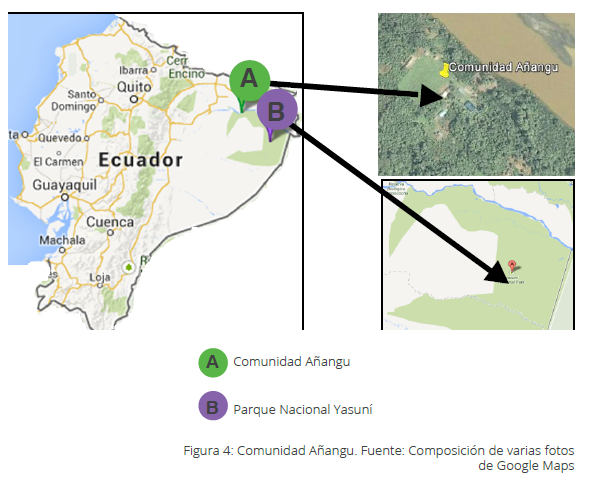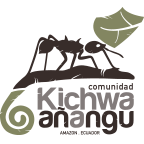WHERE DO WE WEAVE LIFE?
Kichwa Añangu Community
It is located on the right bank of the Napo River if you come from El Coca; it takes approximately two travel hours, about 80km by river. It is bordered to the north by the Napo River, to the south by the Tiputini River, to the east by the commune of Sani Isla, and to the west by the commune of Nueva Providencia.It is important to know that being inside the Yasuní National Park, "Biosphere Reserve" according to Unesco, one of its most important characteristics is its location, in one of the areas with the greatest biodiversity in the world.
Therefore, the community is responsible for the conservation of 21,465.38 hectares within the tropical rainforest of the Ecuadorian Amazon.

Location
- Atmospheric pressure: 0.96 atmospheres
- Area: 21,400 hectares
- Height:: Fluctuates between 300 and 600 masl
- Province: Orellana
- Capital province: Ciudad del Coca
- Canton: Francisco de Orellana
- Parish: Alejandro Labaka
- Coordinates: The distance from the province of Orellana in a straight line to the coast is 392 kilometers; by land by the route Coca-Lago Agrio-Quito-Guayaquil is 770 km.
- Latitude:0 degrees, 29 minutes, 41.27 seconds
- Longitude: 76 degrees, 25 minutes, 8.28 seconds
Yasuní National Park
The Yasuní National Park (YNP), with almost one million hectares, forms a recognized area of very high biodiversity; in addition, it is an important center of endemism called "Punto Caliente" or hotspot. This point, which is one of the most extensive and diverse in South America, is known as the Napo-Ucayali refuge, which is shared with the northern Amazon of Peru. The flora and fauna of the sector, typical of the Napo rainforest region, are very diverse, to the extent that the World Wildlife Foundation (WWF) has declared Yasuní National Park as one of 200 priority sites to conserve globally**.
Yasuní National Park (YNP) was created in 1979. In 1990, by revising its boundaries, the ancestral settlements were recognized and the southern part of the Yasuní National Park (YNP) was declared an intangible zone. This area is home to a group of Waorani Indians who are in voluntary isolation. In 1992 an extension was made to the territory that today includes the territory between the rivers Cononaco and Curaray, which totals an area of 982,000 hectares. (Jorgenson, J. and Rodríguez, M. 2001).
Yasuní National Park is characterized by its high degree of biodiversity of flora and fauna. More than 500 species of birds, 173 species of mammals, 62 species of snakes, more than 100 species of amphibians and a great variety of freshwater fish have been counted. (Ministry of Environment, 2002:7).
In addition to its importance in biological diversity, the YNP is characterized by its cultural value, as its territory is home to peoples and nationalities such as the Kichwa of the Amazon, the Waorani (among whom are the clans of the non-contacted Tagaeri and Taromenane people) and groups of the Shuar nationality. (Mora Garcés, 2011:9).
Yasuní National Park (YNP) was created in 1979. In 1990, by revising its boundaries, the ancestral settlements were recognized and the southern part of the Yasuní National Park (YNP) was declared an intangible zone. This area is home to a group of Waorani Indians who are in voluntary isolation. In 1992 an extension was made to the territory that today includes the territory between the rivers Cononaco and Curaray, which totals an area of 982,000 hectares. (Jorgenson, J. and Rodríguez, M. 2001).
Yasuní National Park is characterized by its high degree of biodiversity of flora and fauna. More than 500 species of birds, 173 species of mammals, 62 species of snakes, more than 100 species of amphibians and a great variety of freshwater fish have been counted. (Ministry of Environment, 2002:7).
In addition to its importance in biological diversity, the YNP is characterized by its cultural value, as its territory is home to peoples and nationalities such as the Kichwa of the Amazon, the Waorani (among whom are the clans of the non-contacted Tagaeri and Taromenane people) and groups of the Shuar nationality. (Mora Garcés, 2011:9).
Yasuní National Park corresponds to the life zone of the tropical rainforest (BHT), its altitude ranges from 200 to 300 meters above sea level; the climate of the region is considered warm-humid with a level of precipitation that oscillates between 2.860 and 3,000 mm annually; the region maintains average temperatures of 24 to 28 degrees Celsius and high humidity with annual values ranging between 86 and 94% (Ministry of the Environment 1999, Romero-Saltos et al. 2001 in Rodríguez et al. 2005:15).
These climatic characteristics of the area favor the development of an immense diversity of animals and plants that are part of one of the most fragile ecosystems in the country; therefore, it is one of those that requires the greatest effort for its conservation.
The origins of the rivers that irrigate Yasuní National Park are diverse.
Some come from the Andes and are known as white water rivers because of the high amount of sediments that drag from the mountain range, and the rivers of black and clear waters that form in the Amazon itself, inside the forests, highlighting the waters that come from the moretals or palm swamps, which are the blackest of all.
These watercourses contain decomposing matter and are differentiated by the intensity of the tannins they acquire from litterfall. The most important bodies of water in the area are: the Napo river, Indillama, Tiputini, Shypati, Jandiayacu, Sabaleta, Yuturi, the lagoon of Añangu and the pipes that flow into the Napo river.
In Yasuní National Park there is a record of about 4,000 plant species, with the possibility that this number will increase. Compared to other tropical areas in the world, Yasuní is the most diverse in terms of number of species per area.
In a single hectare of forest, for example, it has been possible to identify more than 6,000 species of trees.
Species typical of this type of habitat are: the guarumos, the balsa tree, the cedar, the blood of drago with medicinal properties, the palmito and the tagua used to elaborate crafts.
The technical report prepared by scientists concerned about Yasuní*** includes 173 mammal species (80 bat species), 567 bird species, 105 amphibian species, 83 reptile species, 382 fish species and more than 100,000 insect species.
Yasuní protects 25 mammal species classified by CITES as endangered, vulnerable and almost threatened. The Añangu sector, for instance, is a refuge for critically endangered species such as the giant otter (Pteronura brasiliensis) and the Amazonian manatee (Trichechus inunguis).
The incredible variety of birds found in Añangu-NWC is a special attraction for tourists specializing in birdwatching. As a result of this activity, more than 562 species of birds in the sector have been registered. In certain points near the community of Añangu there are two incredible sites for the observation of macaws, parrots and parakeets.
These places called "lamederos" are visited by hundreds of animals of some species during the mornings. The amphibians and reptiles in the Yasuní reach almost 200 species, the fish have around 400 species, although in the future could exceed 600.
More than 100,000 species of insects per hectare have also been recorded, the highest biodiversity of invertebrates known to date. As for mammals, we can mention the following: tapirs, jaguars, ocelots, giant otters; also, among the birds we can highlight: multicolored toucans, tangaras, hummingbirds, etc.






